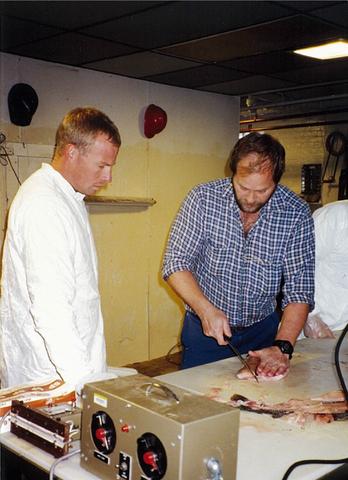
Mark Cronise (left) of NIST’s Office of Reference Materials assists a fisherman in the gutting and filleting of trout from Lake Superior. With further processing back at NIST, the fish tissue is transformed into a reference material that helps environmental monitoring labs with quality control.
NIST scientists have thoroughly measured and characterized more than 1,300 physical products, NIST Standard Reference Materials®, to help people in industry, academia, and government agencies calibrate instruments, verify their test methods, and develop new measurement methods. NIST reference materials, for example, help manufacturers make interoperable parts in far-flung facilities, medical labs check the accuracy of cholesterol and other clinical tests, and scientists monitor environmental threats.
We feature a different NIST reference material in each issue of Material Matters, the quarterly magazine of the Material Measurement Lab. (Click to subscribe.) This story appears in the Fall 2016 issue.
What
Standard Reference Material® 1946 Lake Superior Fish Tissue, and 1947 Lake Michigan Fish Tissue
Mark Cronise isn’t lying about the hundreds of pounds of trout that he and two colleagues helped to fillet, ice, and prepare for shipment to NIST after driving the length of Michigan’s upper peninsula all night. (The collection of Lake Michigan’s trout, scheduled for the same trip, was delayed, so it was shipped to NIST unescorted.) Upon arrival at NIST, each lake’s batch of fish was further frozen to -120 degrees Celsius (-184 degrees Fahrenheit) in liquid nitrogen freezers, then ground to a powder, homogenized in a spinning drum, and bottled, all while still frozen. Each SRM is sold as five bottles of about 8 grams (0.28 ounces) of powdered fish tissue stored at -80 degrees Celsius (-112 degrees Fahrenheit). They are each certified—meaning that NIST and collaborators have performed sophisticated chemical analysis and shown that those results can be repeated—for more than a half dozen elements including mercury, plus a selection of industrial chemicals, pesticides, and fatty acids. NIST continues to test for and add values for chemicals, adding to the utility of the SRMs.
Why
The U.S. Environmental Protection Agency (EPA) has monitored the Great Lakes water quality and ecosystem since the late 1970s. With more than 94,000 square miles of surface area and 30 million people living along their shores, there’s not much that doesn’t end up in the waters of the Great Lakes, from industrial contaminants like polychlorinated biphenyls (PCBs), to mercury, to agricultural pesticides, to other chemicals like the flame retardants used in couches and chairs. (Because Lakes Superior and Michigan differ in the types and amounts of chemicals they contain, NIST developed a fish tissue SRM for each.) PCBs and mercury have been shown to harm people and wildlife. The other substances have been shown to harm animals, although their effects on humans are not well understood. While NIST first developed the fish tissue SRMs to assist the EPA, they are used by environmental monitoring labs around the world to check their sample processes and test methods. The EPA, in particular, is interested in an accurate picture of the lakes’ recovery from now-banned or regulated PCBs and other chemicals, and helping localities give data-backed advice to their residents about how much Great Lakes fish is safe to eat.
In addition to aiding environmental monitoring efforts, the Great Lakes fish tissue SRMs help food industry labs check their analytical methods for measuring fatty acids.
Who
Each year, the EPA collects predator fish from the top of the lakes’ aquatic food chain from each of the Great Lakes. Top predators—the same types of fish usually eaten by people—accumulate toxins ingested by organisms lower in the food chain, so they are good indicators of the chemicals in their environments. Bernard Crimmins of Clarkson University oversees some of the analyses conducted as part of the EPA’s Great Lakes Monitoring Program.
How
Crimmins and Clarkson students rely on NIST fish tissue SRMs to diagnose any problems with their laboratory methods. “These SRMs are great because it’s the actual fish tissue, the same as what we measure,” Crimmins says, adding that just enriching a control with a known amount of chemical doesn’t represent the full complexity of the real-world analytical problem. The NIST SRMs also help the Clarkson students determine whether levels of emerging potential contaminants, such as new flame retardants, have increased compared to the historical levels preserved in the nearly-20-year-old NIST SRMs. Despite their age, the fish tissue SRMs have legs: If kept properly frozen, the SRMs will be good on your shelf until December 2026.
Technical Contact: John Kucklick

